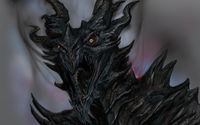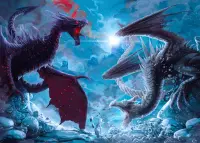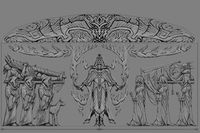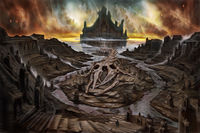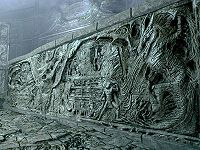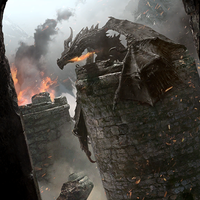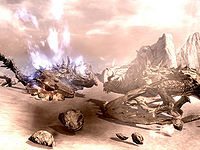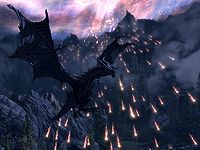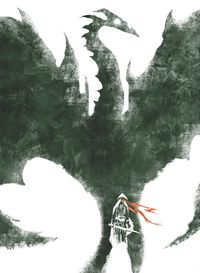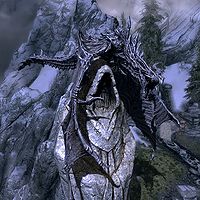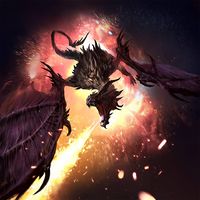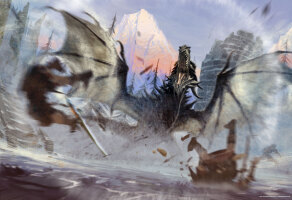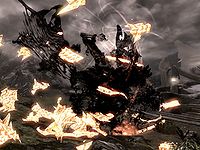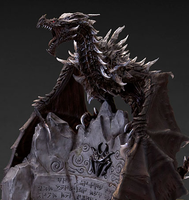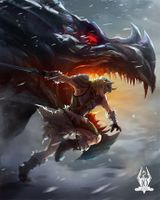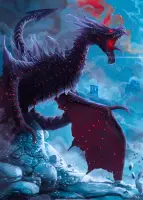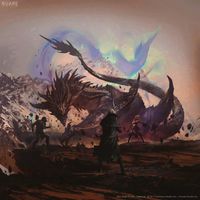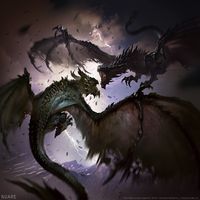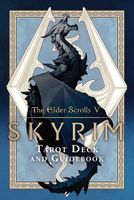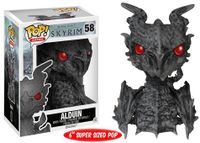Lore:Alduin
| Alduin | |||
|---|---|---|---|
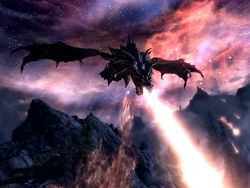 Alduin the World Eater |
|||
| Type | Dragon | ||
| Realm | Nirn, Sovngarde | ||
| Pantheon | Nordic Pantheon (Twilight God) Khajiit Pantheon (The Wandering Spirits) |
||
| Sphere | End of Times | ||
| Servants | Dragons, Dragon Priests, Draugr | ||
| Appears in | |||
Alduin (also spelled Ald'uin[UOL 1] or simply Ald),[UOL 2][UOL 3] known as the World-Eater,[1] the First Dragon,[2] the Dragon Who Eats the World,[3] Time-Eater,[4] the Twilight God,[5] the Worm,[6] the Dragon King,[7] and the Firstborn[8] to the residents of Skyrim, is an immensely powerful black Dragon. He is known as a malevolent being who destroys the world periodically, and the Nords believe that his reappearance heralds the end of the current kalpa and the beginning of the next.[9] He is the self-proclaimed First-Born of Akatosh,[10][11] and supposedly an aspect of him.[UOL 2]
His name can be separated into "Al Du In", which means "Destroyer Devour Master" in the Dragon Language.[12]
History[edit]
Origins[edit]
Alduin and his various aspects (such as the Skaal Thartaag or the Khajiiti Alkhan) serve as the Dragon God of the End Times. Though some mortal sources suggest that Alduin is a Nordic cultural equivalent to the Time Dragon given his nature as a Dragon and his relation to time,[5][1][13] others suggest a more complicated lineage.
Alduin describes himself as "firstborn of Akatosh",[10] with other sources (both mortal and draconic) corroborating this claim.[11][14][15] Some sources make no reference to the father-son relationship between Alduin and Akatosh, but do make a point to distinguish the two from one another.[9][16][17][3] Other parts of Nord folklore describe Alduin as having been shed from Aka-Tusk, an elder dragon totem from the time of the Ehlnofey.[UOL 2][UOL 4] Indeed, all dragons are said to be in some manner related to Akatosh, being his children and/or part of him that split off when time began.[8] Similarly, Pre-Riddle'thar Khajiiti mythology remembers Alkhan as the firstborn offspring of Akha and a mysterious entity only known as a "demon of fire and shadow".[18] While Akha is linked to the Khajiiti Alkosh, they are at least partially distinct figures.[18]
Dawn Era[edit]
Alduin is ascribed the creation of the World in certain Nordic mythology by way of destroying the prior world to begin the current one.[1] At least one Nordic folklore tale speaks to one of these World Eating events. In a previous iteration of the world, Alduin was subject to a scheme by The Greedy Man and the Demon King Dagon, who sought to trap Alduin in a dying world and kill him by tricking him into consuming more than he was able. This scheme was unsuccessful, however, and resulted in Dagon's transformation into the Prince of Destruction.[UOL 2]
The World-Eater was said to have participated in key battles during the Dawn Era with Lorkhan and his various cultural interpretations or aspects.[18][4] The Khajiiti interpretation, Alkhan was said to have been killed by Lorkhaj and his companions during the early days of creation but per his immortal nature as a son of Akha, he eventually returned.[18]
Dragons had existed since the Dawn of time, but they were "uncivilized" creatures.[8] Alduin returned to the affairs of the world and established civilization and order among the dragons, and became their leader.[8] It is said the Dragons ruled over all of Mundus before the birth of men.[19]
Dragon Cult[edit]
This leadership over dragonkind gradually extended to rulership over mankind. This Dragon Cult originated in Atmora but would eventually come south to Tamriel where the humans were lorded over with a much crueler hand.[20] Beyond the more historically documented rule in Tamriel and Atmora, the Dragons at the height of their power were said to rule the whole world.[21] Though all dragons swore fealty to Alduin,[22] his younger brother, Paarthurnax, served as his chief lieutenant and right hand.[23] Others like Kaalgrontiid traveled further south, seeking to establish their own kingdoms outside of Alduin's direct supervision.[24] Under the dragons were certain humans who held a special connection with the dragons known as the Dragon Priests.[20] At the bottom rung lay the mortal servants who lived under the heel of these cruel masters.[20] Alduin was theorized to administer sacrificial rituals of the cult.[25]
Skuldafn was a significant location for the Dragon Cult, know as one of Alduin's high fanes.[26] From here, Alduin could enter a portal that led directly to Sovngarde, allowing him to eat the souls of the Nordic dead, a privilege he guarded jealously.[26] The Dragon Priests of Skuldafn (such as Nahkriin) were said to have stood at Alduin's right hand.[27]
Paarthurnax would eventually have a change of heart.[22] According to the Greybeards of High Hrothgar, Paarthurnax began to pity mankind and was called upon by the goddess Kyne to set things right.[22] Where before the Thu'um had been the sole domain of the Dragons and the chosen few who led the Dragon Cult as priests, Paarthurnax taught it to the mortals of the land in order to give them a means to combat their overlords.[11] Some sources claim this was at the command of Akatosh himself.[20] These humans succeeded in defeating the Dragon Priests and slaughtered the dragons in great number,[20] but had yet to face their most daunting task of all - confronting the cult's almighty God-King, the World-Eater Alduin.
Banishment and Looming Return[edit]
Three of the greatest Proto-Nordic heroes of the age, Felldir the Old, Hakon One-Eye, and Gormlaith Golden-Hilt took the task of defeating Alduin upon themselves.[11] They initially attempted to recruit the Dragon Priest Miraak who thanks to his unique nature as the first Dragonborn in history had a tremendous edge against the foe, but Miraak refused to give aid.[28]
Near the end of the war, these ancient heroes confronted Alduin at the summit of the Throat of the World.[29] With no conventional means to defeat the wyrm, Felldir the Old used an Elder Scroll to perform an incantation that ejected Alduin from their time, propelling him into the future and leaving behind a Time Wound.[29]
The legacy of Alduin in Nordic culture following his banishment varied slightly, but was mostly embodied by reverence and fear. Most Nords still regarded Alduin as a god, namely the Dragon totem of the old Nordic animal totem religion. As a Twilight God who would usher in the next cycle,[5] these Nords held great respect and fear for Alduin, but dared not worship him.[2] Those who did worship him did so in secret, as it was illegal.[30] Peasants spoke of Alduin in hushed tones as they clutched their prayer stones.[31] Alduin was venerated on winter solstices at ancient Dragon Cult temples where prayers and offerings were made in the hopes of the great god of time continuing his slumber for years to come.[5][UOL 5]
In 1E 533 during the reign of High King Ysmir Wulfharth, the Nordic Testing God Orkey summoned an apparition of Alduin to help deal with the king. Despite his banishment, this ghost of Alduin Time-Eater was able to manifest and pose a threat. In this ghostly state, Alduin managed to eat the ages of the majority of the Nordic populace down to six years old, King Wulfharth included. Boy Wulfharth pleaded with the Dead God Shor who had fought Alduin previously in ancient times to help the Nords. Shor's own ghost then did battle with Alduin's in Sovngarde, Shor defeated this shade of the Time-Eater, placing ruin on Orkey's chosen people the Orcs.[4]
Wulfharth, for his part, learned a new thu'um while watching the battle known as What Happens When You Shake the Dragon Just So. Wulfharth used this thu'um to restore the Nords back to their proper ages - inadvertently aging himself to death.[4]
In 1E 2812 Emperor Reman II permitted the construction of Alduin's Wall within Sky Haven Temple.[32] It is considered to be one of the best preserved examples of early Akaviri sculptural relief, as well as a wonder of the ancient world. Its purpose was to record the accumulated dragonlore and prophecy that the Dragonguard possessed at the time.[23] Its main focus was a pictorial representation of the Prophecy of the Dragonborn. The prophecy foretold of five key historical events that would preface Alduin's return after his expulsion during the Dragon War.[33] Given that Alduin's return was inevitable, the Dragonguard believed that the wall was their gift to the generations that were to follow.[23]
Craftsmen from temples across the Empire were called upon to work on the wall, while Grandmaster Jaiv-Yora of the Dragonguard oversaw the construction of the wall,[34] and after six years it was completed. Emperor Reman II returned to the temple in 1E 2818 to officially dedicate the wall. The Blood Seal outside the temple was consecrated in the presence of all Akaviri Dragonguard in Skyrim. This allowed the temple to be sealed, only ever to be opened by a Dragonborn to unlock its knowledge and power.[32]
The presence of dragons caused distress for the Nords who viewed them as the servants of Alduin.[35] Some lighthearted level of respect could be shown for the World Eater in Nord culture, usually manifesting in small ways such as naming one's pet after him.[36]
Nords who viewed Alduin as their local variation of Akatosh were perplexed by the Imperial fascination with Akatosh, as they worked diligently to keep the Time Dragon asleep while their southern cousins sought his attention.[5] Those who did not view Alduin as an aspect of Akatosh instead viewed Akatosh as the Great Dragon and Dragon totem deity.[14][17] Some even called Alduin's godhood into question, placing him below Akatosh in the order of the cosmos.[9][17] Regardless, none denied his role as the harbinger of the End Times. Some outsiders who did not understand this dynamic of acknowledgment and respect, but lack of worship for the World Eater in Nordic culture claim that Nords worshipped the "heathen god" Alduin.[37]
In the Fourth Era, other prophetic deductions formed around Alduin's return. The revived Mythic Dawn Cult leader Vonos had visions which eventually led to the realization that Alduin would re-emerge into the world, the fated Last Dragonborn would rise, and that the two beings would clash despite both being shards of Akatosh's soul.[15]
Return[edit]
In 4E 201, Alduin reappeared at the Throat of the World, cast forth from the Time-Wound created when he had been banished thousands of years before. Perched here was his brother, Paarthurnax, who awaited his return at the summit of the Throat of the World ever since his banishment.[11] However, Paarthurnax was unable to contain Alduin, and the World-Eater descended upon the region. In the midst of all of this, several members of the Stormcloak rebellion were being executed by Imperial Legionnaires in Helgen, including the rebel leader Ulfric Stormcloak.[38] Accidentally caught up in this string of executions was a prisoner who was detained for crossing the border.[38]
Before this prisoner or Ulfric Stormcloak could be executed, Alduin descended upon Helgen and quickly reduced the settlement to rubble. Several parties were able to narrowly escape the destruction including Ulfric and the prisoner.[38] Ulfric Stormcloak's resulting escape prolonged the civil war in Skyrim and secured a steady flow of souls for Alduin to consume in Sovngarde.[39] Alduin began to resurrect his fallen brethren, using a powerful thu'um (seemingly known only to him) to undo their deaths and restore flesh to their bones.[40] Dragon Priests and draugr began to stir in ancient ruins as well, setting the revitalization of Alduin's army and the Dragon Cult in motion. The mysterious prisoner was eventually revealed to be the Last Dragonborn, hero of prophecy.[41]
As a Dragonborn, the hero was able to wield the thu'um with preternatural ease, learning several powerful shouts that allowed them to slay Alduin's dragon allies and absorb their souls, increasing the hero's strength and ensuring Alduin could not revive them again. With the aid of an Elder Scroll, the Last Dragonborn learned the forgotten thu'um known as Dragonrend that served as a great weapon against dragonkind, forcing understanding of mortality into their immortal minds.[29] With this new magic, Paarthurnax and the hero confronted Alduin on the Throat of the World, where the two sides fought to a stalemate. Given his unique nature, it was seemingly impossible to slay Alduin on Mundus.[29]
Eventually, the Dragonborn gained access to Sovngarde, where Alduin had fled to regain strength.[42] Shor gave council for the heroes of Sovngarde to stand down, allowing the Last Dragonborn to face Alduin as foretold with the help of the three ancient Nord heroes who banished Alduin in the first place.[43] With that, the quartet finally vanquished the World-Eater.[42] Alduin's soul was not absorbed by the Dragonborn, and he may not have been completely destroyed:[42] it is possible that he will one day return to fulfill his role as the World-Eater.[22][18]
The surviving dragons had varying reactions to Alduin's vanquishing. Paarthurnax lamented the death of his brother but intended to teach the surviving dragons the philosophy he had come to adopt, the Way of the Voice.[11] Some dragons viewed this attempt at new leadership by Paarthurnax as tyranny, instead bowing to the superiority of the Last Dragonborn, who, as the slayer of Alduin, they felt was the rightful heir to his lordship.[26]
Even realms beyond the Mundus felt ripples from the World-Eater's destruction. A dragon in the Soul Cairn by the name of Durnehviir learned of the event and proclaimed the Last Dragonborn a true Dovah for the deed.[44] Similarly, Miraak, the First Dragonborn in history who was residing in Apocrypha, sensed that the Last Dragonborn had slain Alduin and commended them for it.[28]
Aspects[edit]
While it is a matter of debate if Alduin serves as a local variant of the likes of the Imperial Akatosh, the Khajiiti Alkosh, and the Elven Auriel who govern time in the general sense, it can be inferred that Alduin governs the sphere of the End of Times giving him more definitive ties to aspects that share that duty.
Alkhan[edit]
To the Ancient Khajiit, he is a Wandering Spirit known as Alkhan, The Scaled Prince, and the Firstborn of Akha. Texts that predate the Riddle'Thar Ephiphany claim that Alkhan was born when Akha bred with a demon of fire and shadow. Alkhan grew in size with each soul he ate, and ever hungered for the crown of Alkosh. He was slain by Lorkhaj and his companions, but will return one day along the Many Paths. Lorkhaj, Khenarthi, and Alkosh consider him to be an enemy.[18]
Thartaag[edit]
The Skaal recognize a version of the Adversary who will show up at the End of Seasons under the name Thartaag the World-Devourer.[45]
All-Maker[edit]
In a claim that is seemingly at odds with the idea of Alduin being connected to the Skaal's malevolent Adversary, some sources instead postulate that the benevolent All-Maker of the Skaal is a distant echo of Alduin.[21]
Satakal[edit]
Satakal of the Yokudan pantheon shares aspects of, and is much like the Nordic Alduin, destroying one world to begin the next.[1][46] The two beings also share similar appellations, with Alduin being known as the First Dragon, and Satakal the First Wyrm and First Serpent.[47][48]
Atakota[edit]
The Argonian Atakota shares some traits with Alduin: each of its scales was a world that it devoured.[49]
Gallery[edit]
Notes[edit]
- Some scholars have speculated that a dragon's soul, once severed from its body, may simply dissolve over time or return to join Akatosh. Since Alduin's soul was not consumed by the Last Dragonborn despite his body being destroyed, this may help explain his ultimate fate.[24]
- Alduin's Time-Eater title is shared by an individual known as Hungunthar Time-Eater who was said to have slayed the Kings of the East and conquered Dunkreath.[50]
- Michael Kirkbride suggested that Alduin's downfall was possibly orchestrated by Akatosh, who time-schemed against his mirror brother to protect the current (and perhaps his favorite) Kalpa from being eaten.[UOL 6]
- One of Ysgramor's Companions was said to be Karkux the Tower of Meat, who even the karstaag-men feared Alduin could not eat ever in whole.[UOL 1]
See Also[edit]
- For game-specific information, see the Skyrim and Legends
 articles.
articles. - For related information, see entries for Akatosh, Auri-El, Alkosh, and the One.
Books[edit]
- The Alduin/Akatosh Dichotomy by Alexandre Simon, High Priest of the Akatosh Chantry, Wayrest — A priest's deductions on the relation between Akatosh and Alduin
- Alduin is Real by Thromgar Iron-Head — A poorly spelled essay from a "prowd Nord" on the difference between Alduin and Akatosh
- Divines and the Nords by High Priest Ingurt — A text on how ancient Nordic totemic religion transformed into modern worship of the Eight Divines
References[edit]
- ^ a b c d Varieties of Faith... — Brother Mikhael Karkuxor of the Imperial College
- ^ a b The Song of Gods
- ^ a b Artorius Ponticus Answers Your Questions — Bishop Artorius Ponticus
- ^ a b c d Five Songs of King Wulfharth
- ^ a b c d e Divines and the Nords — High Priest Ingurt
- ^ Tsun's dialogue in Skyrim
- ^ Official ESO website: Ask Us Anything: Gathering and Exploration
- ^ a b c d Shalidor's Insights — Shalidor
- ^ a b c Alduin is Real — Thromgar Iron-Head
- ^ a b Alduin's dialogue in Skyrim
- ^ a b c d e f Paarthurnax's dialogue in Skyrim
- ^ The Elder Scrolls V: Skyrim: Prima Official Game Guide — David Hodgson
- ^ The Tale of Dro'Zira — Sonia Vette
- ^ a b Temples of the Dragon Cult — Cirantille
- ^ a b Vonos' Journal — Vonos
- ^ Apprentice Taz's dialogue in ESO: Elsweyr
- ^ a b c The Alduin/Akatosh Dichotomy — Alexandre Simon, High Priest of the Akatosh Chantry, Wayrest
- ^ a b c d e f The Wandering Spirits — Amun-dro, the Silent Priest
- ^ Etched Tablets of High Hrothgar in Skyrim
- ^ a b c d e The Dragon War — Torhal Bjorik
- ^ a b The Guardian and the Traitor — Lucius Gallus
- ^ a b c d Arngeir's dialogue in Skyrim
- ^ a b c Esbern's dialogue in Skyrim
- ^ a b Loremaster's Archive - Dragons in the Second Era — Camilla Calsivius
- ^ Ruby Dragon Skull antiquities codex entry in ESO: Greymoor
- ^ a b c Odahviing's dialogue in Skyrim
- ^ The Improved Emperor's Guide to Tamriel: Skyrim — Flaccus Terentius, 2E 581
- ^ a b Miraak's dialogue in Skyrim: Dragonborn
- ^ a b c d Alduin's Bane quest in Skyrim
- ^ Jewel-Encrusted Dragon Cult Idol item description in ESO
- ^ Arlof's dialogue in ESO: Greymoor
- ^ a b Annals of the Dragonguard — Brother Annulus
- ^ The Book of the Dragonborn — Prior Emelene Madrine
- ^ Grandmaster Jaiv-Yora
- ^ Dragon Sightings during the Dragon Rise event in ESO
- ^ Alduin in ESO
- ^ Jeleen's dialogue in Morrowind: Bloodmoon
- ^ a b c Unbound quest in Skyrim
- ^ Civil War questline in Skyrim
- ^ A Blade in the Dark quest in Skyrim
- ^ Dragon Rising quest in Skyrim
- ^ a b c Dragonslayer quest in Skyrim
- ^ Ysgramor's dialogue in Skyrim
- ^ Durnehviir's dialogue in Skyrim: Dawnguard
- ^ Aevar Stone-Singer
- ^ The Improved Emperor's Guide to Tamriel: Hammerfell — Flaccus Terentius, 2E 581
- ^ Redguard exclamations in Daggerfall
- ^ Satakal Skinrazer antiquity codex entry in ESO: Greymoor
- ^ Children of the Root — Solis Aduro
- ^ Slow Time word wall in Skyrim
Note: The following references are considered to be unofficial sources. They are included to round off this article and may not be authoritative or conclusive.
| ||||||||||||||||||||||||||||||
